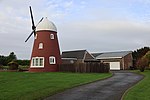Oxenbourne Down, Clanfield
Local Nature Reserves in Hampshire

Oxenbourne Down, Clanfield is a 84.8-hectare (210-acre) Local Nature Reserve north of Clanfield in Hampshire. It is owned and managed by Hampshire County Council. It is part of Butser Hill, which is a Special Area of Conservation and Site of Special Scientific Interest.This is part of Queen Elizabeth Country Park. It has unimproved grassland on low fertility soils, which is controlled by grazing. There are also areas of ancient semi-natural woodland.
Excerpt from the Wikipedia article Oxenbourne Down, Clanfield (License: CC BY-SA 3.0, Authors, Images).Oxenbourne Down, Clanfield
London Road, East Hampshire Buriton
Geographical coordinates (GPS) Address Nearby Places Show on map
Geographical coordinates (GPS)
| Latitude | Longitude |
|---|---|
| N 50.966 ° | E -0.986 ° |
Address
London Road
GU31 5SP East Hampshire, Buriton
England, United Kingdom
Open on Google Maps








